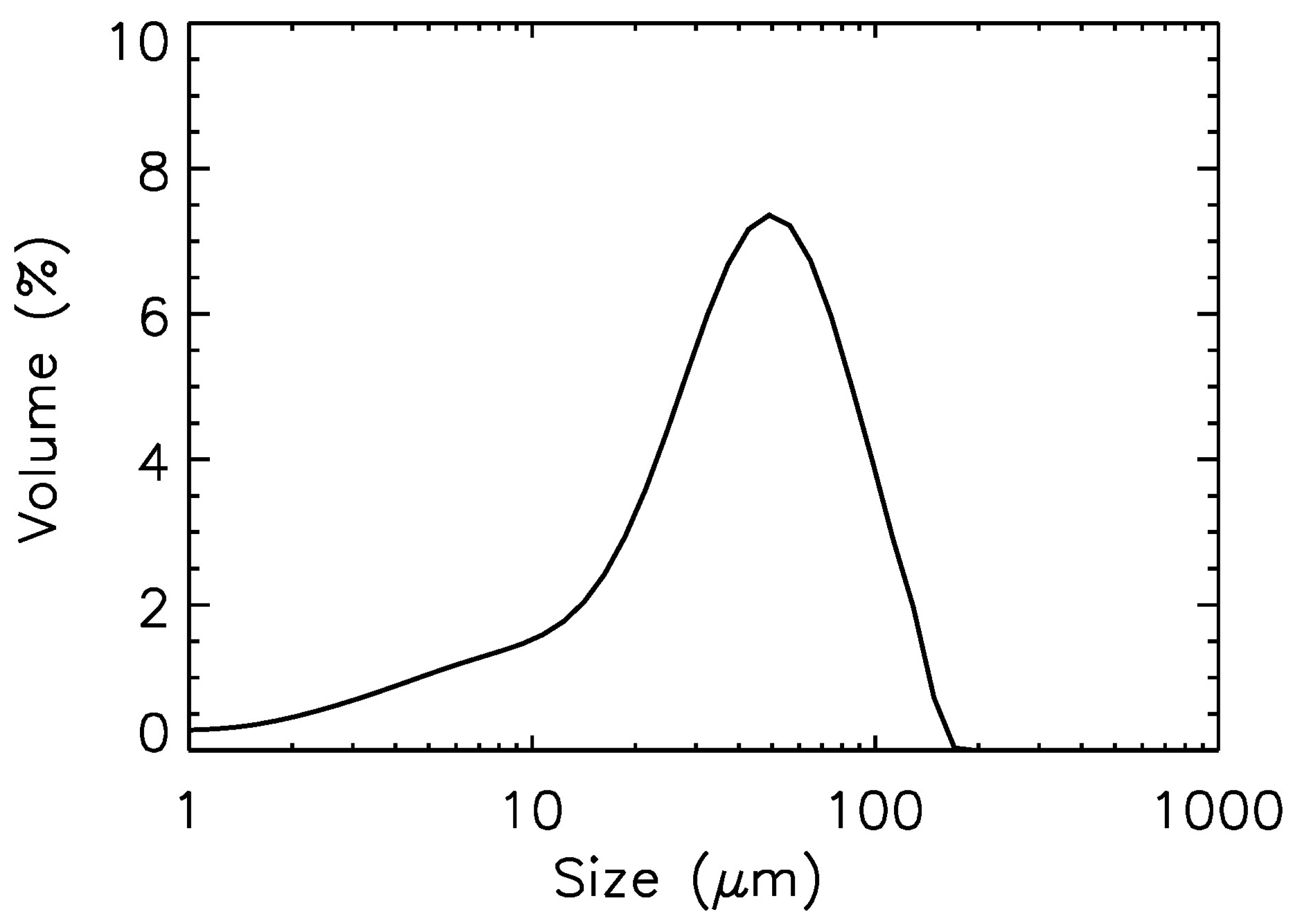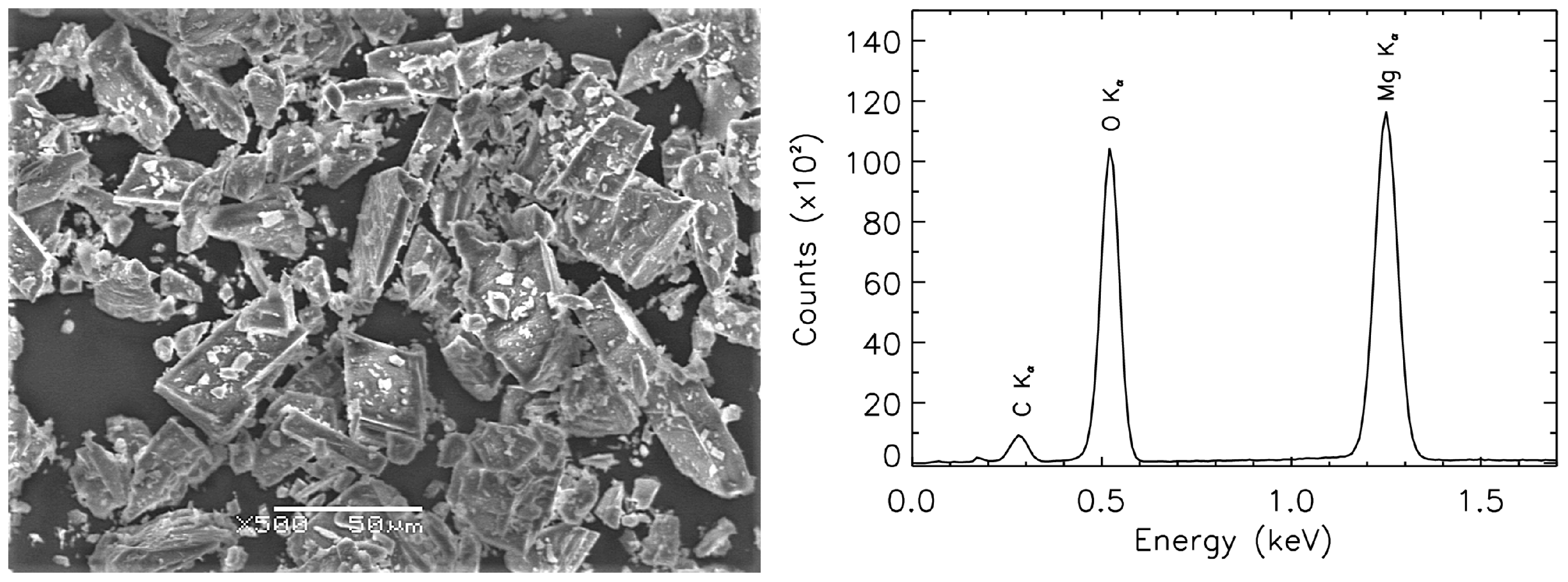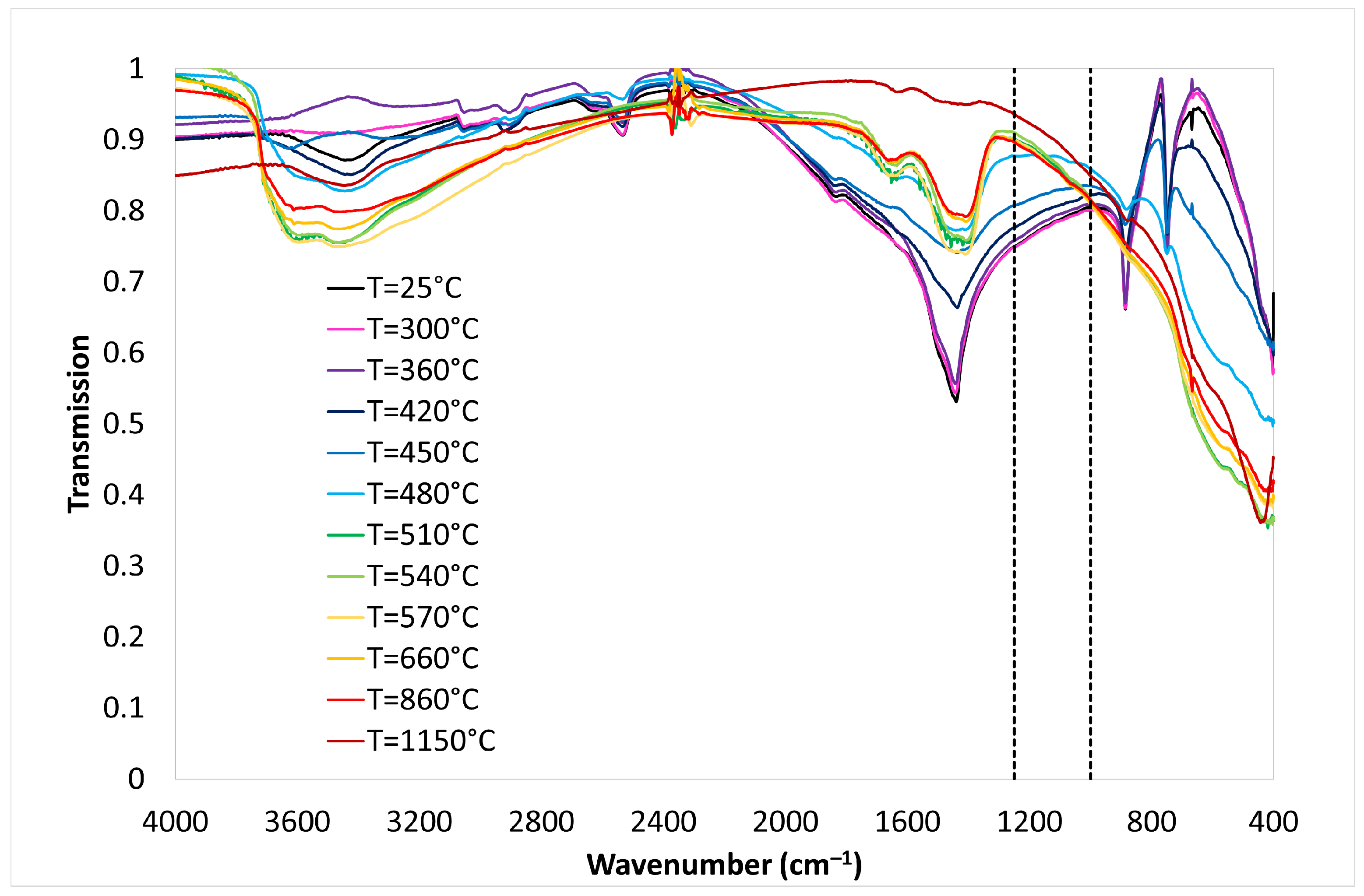Kinetics of Thermal Decomposition of Particulate Samples of MgCO3: Experiments and Models
Abstract
:1. Introduction
2. Laboratory Measurements of Magnesite Decomposition
2.1. Sample Preparation and Characterizations
2.2. Thermal Process
2.3. Gravimetric and Spectral Measurements
3. Theoretical Model
4. Results and Discussion
5. Conclusions
Author Contributions
Funding
Data Availability Statement
Conflicts of Interest
References
- Mackenzie, F.T. Carbonate mineralogy and geochemistry. In Encyclopedia of Sediments and Sedimentary Rocks; Middleton, G.V., Church, M.J., Coniglio, M., Hardie, L.A., Longstaffe, F.J., Eds.; Springer Netherlands: Dordrecht, The Netherlands, 1978; pp. 93–100. [Google Scholar] [CrossRef]
- de Pater, I.; Lissauer, J.J. Planetary Sciences, 2nd ed.; Cambridge University Press: Cambridge, UK, 2010. [Google Scholar] [CrossRef]
- Ehlmann, B.L.; Mustard, J.F.; Murchie, S.L.; Poulet, F.; Bishop, J.L.; Brown, A.J.; Calvin, W.M.; Clark, R.N.; Marais, D.J.; Milliken, R.E.; et al. Orbital identification of carbonate-bearing rocks on Mars. Science 2008, 322, 1828–1832. [Google Scholar] [CrossRef] [PubMed] [Green Version]
- Boynton, W.; Ming, D.; Kounaves, S.; Young, S.; Arvidson, R.; Hecht, M.; Hoffman, J.; Niles, P.; Hamara, D.; Quinn, R.; et al. Evidence for calcium carbonate at the Mars Phoenix landing site. Science 2009, 325, 61–64. [Google Scholar] [CrossRef] [PubMed] [Green Version]
- Palomba, E.; Zinzi, A.; Cloutis, E.A.; d’Amore, M.; Grassi, D.; Maturilli, A. Evidence for Mg-rich carbonates on Mars from a 3.9 µm absorption feature. Icarus 2009, 203, 58–65. [Google Scholar] [CrossRef] [Green Version]
- Gooding, J.L.; Wentworth, S.J.; Zolensky, M.E. Calcium carbonate and sulfate of possible extraterrestrial origin in the EETA 79001 meteorite. Geochim. Cosmochim. Acta 1988, 52, 909–915. [Google Scholar] [CrossRef]
- Wentworth, S.J.; Gooding, J.L. Carbonates and sulfates in the Chassigny meteorite: Further evidence for aqueous chemistry on the SNC parent planet. Meteoritics 1994, 29, 860–863. [Google Scholar] [CrossRef]
- Wray, J.J.; Murchie, S.L.; Bishop, J.L.; Ehlmann, B.L.; Milliken, R.E.; Wilhelm, M.B.; Seelos, K.D.; Chojnacki, M. Orbital evidence for more widespread carbonate-bearing rocks on Mars. J. Geophys. Res. Planets 2016, 121, 652–677. [Google Scholar] [CrossRef] [Green Version]
- Rivkin, A.; Volquardsen, E.; Clark, B. The surface composition of Ceres: Discovery of carbonates and iron-rich clays. Icarus 2006, 185, 563–567. [Google Scholar] [CrossRef]
- De Sanctis, M.C.; Raponi, A.; Ammannito, E.; Ciarniello, M.; Toplis, M.; McSween, H.; Castillo-Rogez, J.; Ehlmann, B.; Carrozzo, F.G.; Marchi, S.; et al. Bright carbonate deposits as evidence of aqueous alteration on (1) Ceres. Nature 2016, 536, 54–57. [Google Scholar] [CrossRef]
- Fomenkova, M.; Kerridge, J.; Marti, K.; McFadden, L.A. Compositional trends in rock-forming elements of comet Halley dust. Science 1992, 258, 266–269. [Google Scholar] [CrossRef]
- Busemann, H.; Nguyen, A.N.; Cody, G.D.; Hoppe, P.; Kilcoyne, A.D.; Stroud, R.M.; Zega, T.J.; Nittler, L.R. Ultra-primitive interplanetary dust particles from the comet 26P/Grigg–Skjellerup dust stream collection. Earth Planet. Sci. Lett. 2009, 288, 44–57. [Google Scholar] [CrossRef]
- Kemper, F.; Jäger, C.; Waters, L.; Henning, T.; Molster, F.; Barlow, M.; Lim, T.; De Koter, A. Detection of carbonates in dust shells around evolved stars. Nature 2002, 415, 295–297. [Google Scholar] [CrossRef]
- Micca Longo, G.; D’Elia, M.; Fonti, S.; Longo, S.; Mancarella, F.; Orofino, V. Kinetics of white soft minerals (WSMs) decomposition under conditions of interest for astrobiology: A theoretical and experimental study. Geosciences 2019, 9, 101. [Google Scholar] [CrossRef] [Green Version]
- Shirokova, L.S.; Mavromatis, V.; Bundeleva, I.A.; Pokrovsky, O.S.; Bénézeth, P.; Gérard, E.; Pearce, C.R.; Oelkers, E.H. Using Mg isotopes to trace cyanobacterially mediated magnesium carbonate precipitation in alkaline lakes. Aquat. Geochem. 2013, 19, 1–24. [Google Scholar] [CrossRef]
- Carter, J.; Poulet, F. Orbital identification of clays and carbonates in Gusev crater. Icarus 2012, 219, 250–253. [Google Scholar] [CrossRef]
- Bishop, J.L.; Tirsch, D.; Tornabene, L.L.; Jaumann, R.; McEwen, A.S.; McGuire, P.C.; Ody, A.; Poulet, F.; Clark, R.N.; Parente, M.; et al. Mineralogy and morphology of geologic units at Libya Montes, Mars: Ancient aqueously derived outcrops, mafic flows, fluvial features, and impacts. J. Geophys. Res. Planets 2013, 118, 487–513. [Google Scholar] [CrossRef] [Green Version]
- Horgan, B.H.; Anderson, R.B.; Dromart, G.; Amador, E.S.; Rice, M.S. The mineral diversity of Jezero crater: Evidence for possible lacustrine carbonates on Mars. Icarus 2020, 339, 113526. [Google Scholar] [CrossRef]
- Sheila, D. Thermal analysis studies on the decomposition of magnesite. Int. J. Miner. Process. 1993, 37, 73–88. [Google Scholar] [CrossRef]
- Tian, L.; Tahmasebi, A.; Yu, J. An experimental study on thermal decomposition behavior of magnesite. J. Therm. Anal. Calorim. 2014, 118, 1577–1584. [Google Scholar] [CrossRef]
- Van de Hulst, H.C. Light Scattering: By Small Particles; John Wiley & Sons: New York, NY, USA, 1957; ISBN 0486642283. [Google Scholar]
- Kerker, M. The Scattering of Light, and Other Electromagnetic Radiation; Academic Press: New York, NY, USA, 1969; ISBN 9780124045507. [Google Scholar]
- Bohren, C.F.; Huffman, D.R. Absorption and Scattering of Light by Small Particles; John Wiley & Sons: New York, NY, USA, 2008; ISBN 9783527618156. [Google Scholar]
- Kippax, P. Measuring particle size using modern laser diffraction techniques. Paint. Coatings Ind. 2005, 21, 42–47. [Google Scholar]
- Zhou, Y.G.; Li, D.; Wang, L.J.; Özkan, N.; Chen, X.D.; Mao, Z.H. Influences of microemulsion cross-linking reaction and ball-milling on particle size characteristics of potato and maize starches. Int. J. Food Eng. 2006, 2, 4. [Google Scholar] [CrossRef]
- Gabas, N.; Hiquily, N.; Laguérie, C. Response of laser diffraction particle sizer to anisometric particles. Part. Part. Syst. Charact. 1994, 11, 121–126. [Google Scholar] [CrossRef]
- Allen, T. Particle Size Measurement; Springer: Berlin/Heidelberg, Germany, 1997; Volume 2, ISBN 978-0412753503. [Google Scholar]
- Orofino, V.; Blanco, A.; D’Elia, M.; Licchelli, D.; Fonti, S. Infrared transmission spectroscopy of carbonate samples of biotic origin relevant to Mars exobiological studies. Icarus 2007, 187, 457–463. [Google Scholar] [CrossRef]
- Kissinger, H.E. Reaction kinetics in differential thermal analysis. Anal. Chem. 1957, 29, 1702–1706. [Google Scholar] [CrossRef]
- Cabane, M.; Coll, P.; Szopa, C.; Israel, G.; Raulin, F.; Sternberg, R.; Mahaffy, P.; Person, A.; Rodier, C.; Navarro-Gonzalez, R.; et al. Did life exist on Mars? Search for organic and inorganic signatures, one of the goals for “SAM” (sample analysis at Mars). Adv. Space Res. 2004, 33, 2240–2245. [Google Scholar] [CrossRef]
- White, R.G. Handbook of Industrial Infrared Analysis; CRC Press: Boca Raton, FL, USA, 1964. [Google Scholar]
- Fridmann, S. Pelleting techniques in infrared analysis: A review and evaluation. Prog. Infrared Spectrosc. 1967, 3, 1–23. [Google Scholar]
- Yang, N.; Yue, W. Inorganic Non-Metallic Materials Atlas Manual; Wuhan University of Technology Press: Wuhan, China, 2000. [Google Scholar]
- Calvin, W.M.; King, T.V.; Clark, R.N. Hydrous carbonates on Mars?: Evidence from Mariner 6/7 infrared spectrometer and ground-based telescopic spectra. J. Geophys. Res. Planets 1994, 99, 14659–14675. [Google Scholar] [CrossRef]
- Jouglet, D.; Poulet, F.; Milliken, R.; Mustard, J.; Bibring, J.P.; Langevin, Y.; Gondet, B.; Gomez, C. Hydration state of the Martian surface as seen by Mars Express OMEGA: 1. Analysis of the 3 µm hydration feature. J. Geophys. Res. Planets 2007, 112, E8. [Google Scholar] [CrossRef] [Green Version]
- Orofino, V.; Blanco, A.; D’Elia, M.; Fonti, S.; Licchelli, D. Time-dependent degradation of biotic carbonates and the search for past life on Mars. Planet. Space Sci. 2009, 57, 632–639. [Google Scholar] [CrossRef]
- Brown, M.E.; Dollimore, D.; Galwey, A.K. Theory of Solid State Reaction Kinetics. Compr. Chem. Kinet. React. Solid State 1980, 22, 41–113. [Google Scholar]
- Britton, H.T.; Gregg, S.J.; Winsor, G.W. The calcination of dolomite. Part I.—The kinetics of the thermal decomposition of calcite and of magnesite. Trans. Faraday Soc. 1952, 48, 63–70. [Google Scholar] [CrossRef]
- Samtani, M.; Dollimore, D.; Alexander, K. Comparison of dolomite decomposition kinetics with related carbonates and the effect of procedural variables on its kinetic parameters. Thermochim. Acta 1991, 189, 135–145. [Google Scholar] [CrossRef]
- Hurst, H.J. The thermal decomposition of magnesite in nitrogen. Thermochim. Acta 1991, 392, 91–96. [Google Scholar] [CrossRef]
- Love, S.G.; Brownlee, D.E. Heating and thermal transformation of micrometeoroids entering the Earth’s atmosphere. Icarus 1991, 89, 26–43. [Google Scholar] [CrossRef]
- Vondrak, T.; Plane, J.M.; Broadley, S.; Janches, D. A chemical model of meteoric ablation. Atmos. Chem. Phys. 2008, 8, 7015–7031. [Google Scholar] [CrossRef] [Green Version]
- L’vov, B. The physical approach to the interpretation of the kinetics and mechanisms of thermal decomposition of solids: The state of the art. Thermochim. Acta 2001, 372, 97–124. [Google Scholar] [CrossRef]
- Longo, G.M.; Longo, S. Thermal decomposition of MgCO3 during the atmospheric entry of micrometeoroids. Int. J. Astrobiol. 2017, 16, 368–378. [Google Scholar] [CrossRef]
- Longo, G.M.; Longo, S. Theoretical analysis of the atmospheric entry of sub-mm meteoroids of MgxCa1–xCO3 composition. Icarus 2018, 310, 194–202. [Google Scholar] [CrossRef]
- Bisceglia, E.; Longo, G.M.; Longo, S. Thermal decomposition rate of MgCO3 as an inorganic astrobiological matrix in meteorites. Int. J. Astrobiol. 2017, 16, 130–136. [Google Scholar] [CrossRef]
- Atkins, P.; Paula, J. Physical Chemistry, 7th ed.; John Wiley&Sons, Inc.: Hoboken, NJ, USA, 2002. [Google Scholar]
- Chase, M.W., Jr. NIST-JANAF Thermochemical Tables, Fourth Edition. Phys. Chem. Ref. Data Monogr. 1998, 9, 1–1951. [Google Scholar]




Publisher’s Note: MDPI stays neutral with regard to jurisdictional claims in published maps and institutional affiliations. |
© 2022 by the authors. Licensee MDPI, Basel, Switzerland. This article is an open access article distributed under the terms and conditions of the Creative Commons Attribution (CC BY) license (https://creativecommons.org/licenses/by/4.0/).
Share and Cite
Mancarella, F.; D’Elia, M.; Micca Longo, G.; Longo, S.; Orofino, V. Kinetics of Thermal Decomposition of Particulate Samples of MgCO3: Experiments and Models. Chemistry 2022, 4, 548-559. https://doi.org/10.3390/chemistry4020039
Mancarella F, D’Elia M, Micca Longo G, Longo S, Orofino V. Kinetics of Thermal Decomposition of Particulate Samples of MgCO3: Experiments and Models. Chemistry. 2022; 4(2):548-559. https://doi.org/10.3390/chemistry4020039
Chicago/Turabian StyleMancarella, Francesca, Marcella D’Elia, Gaia Micca Longo, Savino Longo, and Vincenzo Orofino. 2022. "Kinetics of Thermal Decomposition of Particulate Samples of MgCO3: Experiments and Models" Chemistry 4, no. 2: 548-559. https://doi.org/10.3390/chemistry4020039
APA StyleMancarella, F., D’Elia, M., Micca Longo, G., Longo, S., & Orofino, V. (2022). Kinetics of Thermal Decomposition of Particulate Samples of MgCO3: Experiments and Models. Chemistry, 4(2), 548-559. https://doi.org/10.3390/chemistry4020039






